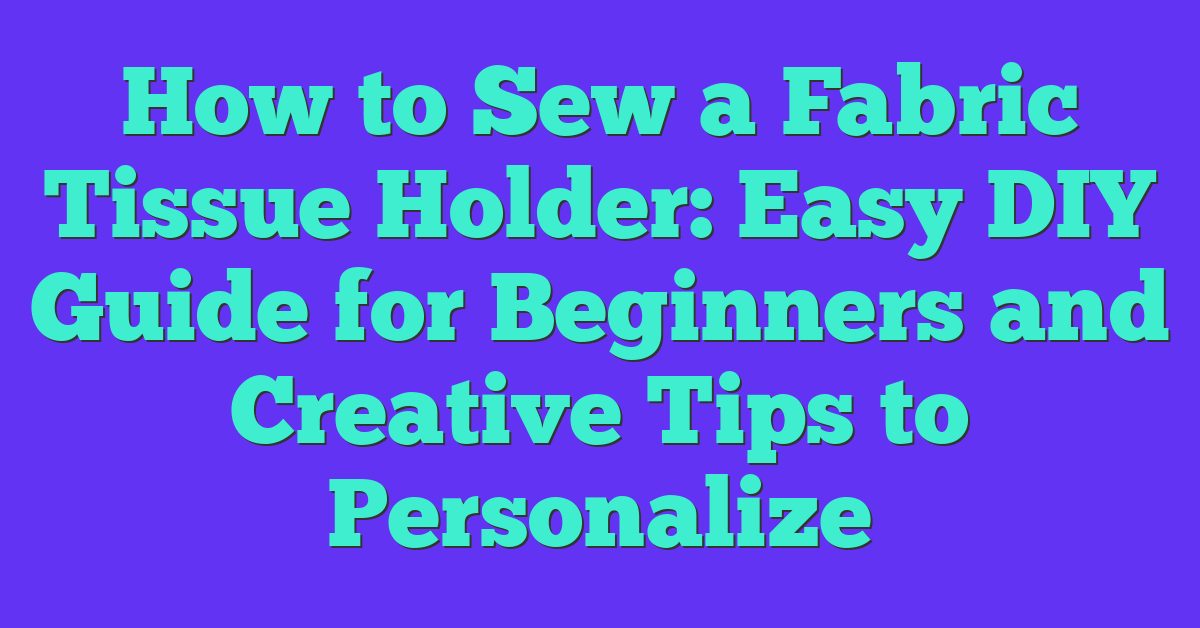Crafting the perfect garment starts with understanding the fundamentals, and mastering the dart is a game-changer. I remember the first time I struggled with getting that precise fit—it was frustrating, but it pushed me to dive deeper into fabric shaping techniques.
Exploring different dart techniques not only enhances the silhouette of your creations but also boosts your confidence as a sewist. Whether you’re tailoring a dress or customizing a jacket, knowing how to shape fabric with precision makes all the difference. Let’s embark on this journey together and transform your sewing skills one dart at a time.
Importance of Darts in Fabric Shaping
Darts are essential for achieving a precise fit and enhancing the structure of garments. They allow fabric to conform to the body’s contours effectively.
Enhancing Fit and Structure
Darts adjust fabric to match the body’s shape, ensuring garments fit seamlessly. They eliminate excess fabric, precisely contouring areas like the neckline and waist. For example, waist darts create a flattering silhouette in dresses and jackets by shaping the garment to the natural waistline. Additionally, darts contribute to the garment’s stability, preventing sagging or bunching in critical points.
Creating Design Details
Darts introduce aesthetic elements to a garment’s design, adding visual interest and distinct lines. They can serve as design features, enhancing the overall appearance. For instance, box pleat darts create intricate patterns on skirts, while triangular darts enhance the design of tailored blazers. Incorporating creative dart placements allows me to personalize each piece, making unique and stylish clothing items.
Essential Dart Techniques
Mastering dart techniques enhances garment fit and structure. Implementing precise methods ensures professional results.
Measuring and Marking Darts
Accurate measurements determine dart placement. I use a measuring tape to mark the fabric at the correct points. Typically, I measure the waist or bust area, noting the exact distance for dart length and depth. Tools like tailor’s chalk and rulers aid in creating clear guidelines. Ensuring symmetry involves marking both sides equally, maintaining garment balance. Double-checking measurements prevents errors before sewing.
Sewing and Pressing Darts
Sewing darts requires precision and consistency. I start by pinning the marked darts to secure the fabric layers. Using a straight stitch, I sew along the dart lines, maintaining even tension to avoid puckering. After stitching, pressing the darts flat with an iron shapes the fabric correctly. Pressing directs the fabric into the desired angle, enhancing the garment’s silhouette. Proper pressing techniques ensure darts lie smoothly, contributing to a professional finish.
Common Challenges and Solutions
Mastering dart shaping involves overcoming several common challenges. Addressing these issues enhances the accuracy and aesthetics of your garments.
Common Mistakes in Dart Shaping
- Inaccurate Measurements: Measuring errors lead to uneven darts.
- Improper Dart Placement: Incorrect positioning affects garment fit.
- Uneven Sewing Tension: Inconsistent tension creates puckered seams.
- Insufficient Pressing: Poor pressing results in bulky or misshapen darts.
- Ignoring Fabric Grain: Misaligned grain disrupts garment structure.
Tips for Perfect Darts
- Take Precise Measurements: Use a flexible measuring tape for accuracy.
- Mark Clearly: Utilize tailor’s chalk or fabric markers for clear dart lines.
- Pin Correctly: Align dart points precisely before sewing.
- Maintain Even Tension: Sew darts with consistent thread tension to prevent puckering.
- Press Carefully: Press darts flat with an iron to ensure a smooth finish.
- Align Fabric Grain: Ensure darts follow the fabric’s grain for optimal fit and structure.
By avoiding common mistakes and applying these tips, you can achieve flawless darts that enhance your garment’s fit and appearance.
Advanced Dart Shaping Techniques
Manipulating Dart Angles for Enhanced Fit
Adjusting the angle of your darts can significantly alter the garment’s fit. I experiment with dart angles to better contour the fabric around different body shapes. By angling darts towards the bust or waist, I achieve a more tailored silhouette. This technique is especially useful for creating fitted tops and dresses.
Combining Darts with Other Seam Techniques
Integrating darts with princess seams or gathering techniques enhances garment structure. I often merge darts with side seams to provide additional shaping without adding bulk. This combination allows for smoother transitions and a more refined finish in areas like the torso and hips.
Utilizing Curved and Reverse Darts
Curved darts offer a softer transition in the fabric, ideal for flowing garments like skirts and blouses. I incorporate reverse darts to create volume where needed, such as in peplum designs. These variations provide versatility in shaping, allowing for both fitted and relaxed styles within a single garment.
Implementing Multiple Darts for Complex Shapes
For intricate designs, I use multiple darts to control fabric movement precisely. This approach is effective in garments with asymmetrical features or unique design elements. By strategically placing multiple darts, I ensure balanced shaping and maintain the garment’s overall integrity.

Advanced Pressing Techniques
Proper pressing is crucial for advanced dart shaping. I press darts open or to one side, depending on the desired finish. Using a steam iron, I carefully flatten each dart to set the shape permanently. This step enhances the garment’s appearance and ensures the darts lay smoothly against the fabric.
Adjusting Dart Dimensions for Different Fabrics
Different fabrics respond uniquely to dart shaping. I adjust dart length and width based on fabric weight and stretch. For lightweight materials, I use narrower darts to avoid excess fabric gathering. Conversely, heavier fabrics accommodate wider darts, providing the necessary shaping without compromising comfort.
Customizing Dart Placement through Pattern Alterations
Altering dart placement allows for personalized fits and unique designs. I modify existing patterns by shifting darts slightly forward or backward to better match specific body measurements. This customization ensures each garment fits perfectly, enhancing both comfort and style.
Summary of Advanced Dart Techniques
| Technique | Purpose | Best For |
|---|---|---|
| Dart Angle Manipulation | Enhanced contouring | Fitted tops, dresses |
| Combining Seam Techniques | Structured shaping without bulk | Torso, hips |
| Curved and Reverse Darts | Soft transitions and added volume | Flowing garments, peplums |
| Multiple Darts Implementation | Precise control for complex shapes | Asymmetrical designs |
| Advanced Pressing | Smooth finish and permanent shape setting | All garment types |
| Adjusting Dart Dimensions | Adaptation to different fabric weights/stretch | Lightweight and heavy fabrics |
| Pattern Alterations | Personalized fits and unique designs | Custom-fit garments |
By mastering these advanced dart shaping techniques, I elevate the precision and creativity of my sewing projects. Each method offers distinct advantages, enabling the creation of garments that not only fit perfectly but also showcase intricate design details.
Conclusion
Mastering darts has truly transformed my sewing projects, making each garment fit better and look more polished. It’s been a rewarding journey overcoming initial challenges and seeing the positive impact precise darts have on my creations. I encourage you to keep experimenting with different dart techniques and embrace the nuances they bring to your work. With practice and patience, you’ll find your confidence growing and your sewing skills reaching new heights. Happy sewing!

















